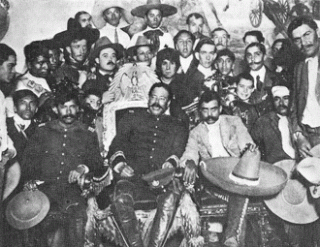From Oppression to Liberation: Mexico’s Revolutionary Struggle.
Miguel, a devoted follower of Emiliano Zapata, finds himself caught up in the midst of the Mexican Revolution as a peon. From the early days of the uprising, he witnesses the struggles and triumphs of the Zapatistas as they fight for land reform and social justice. He participates in battles, sees the horrors of war, and experiences the exhilaration of victory. Through it all, Miguel remains committed to the cause, even as he grapples with the personal costs of revolution. As the conflict rages on, Miguel must confront difficult questions about loyalty, sacrifice, and the true meaning of freedom.
The Mexican revolution was successful in that it resulted in the overthrow of the long-standing dictatorship of Porfirio Diaz and the establishment of a more democratic government. The revolution also led to the adoption of a new constitution in 1917, which included important provisions for land reform, labor rights, and social welfare.
However, the revolution did not completely solve all of Mexico’s problems. The country continued to face challenges such as poverty, inequality, and corruption in the years following the revolution. Additionally, the revolution was marked by significant violence and conflict, and many of its promises were not fully realized.
The Battle for Democracy: A Retrospective on the Mexican Revolution.
“A rebellion against tyranny, a triumph of democracy, and a testament to the power of ordinary people to change the course of history.”
— Andres Manuel Lopez Obrador, President of Mexico.

Bienvenidos! Get ready to embark on a journey to one of the most fascinating but chaotic periods of Mexican history: the Mexican Revolution. This was a time of tremendous change, as people from places all across the nation came together to fight together against injustice, oppression, and inequality. The period of revolutionaries fighting against the old regime to determine the country’s future. In this video, we’ll explore the key events, figures, and ideas that shaped the Mexican Revolution and discover how this epic nation transformed from a powerful dictatorship to a justice democracy under the influence of peasants and the fall of the middle and high classes. Thus, fasten your seatbelts and get ready for an unforgettable ride through one of the most critical chapters in Mexican history. Vámonos!
Photo Citation:
Admin. The 1914 Convention of Aguascalientes – Pedroza Place. 12 May 2014, www.johnpedroza.com/blog1/the-1914-convention-of-aguascalientes.
Quiet.
“Open your suitcase for others to see, because the world needs you and the things you carry.” — Susan Cain
In Quiet Power: The Secret Strengths of Introverted Kids by Susan Cain, introversion is portrayed throughout the story. This book addresses commonly held stereotypes, misconceptions, and individual definitions through various narratives of students across the globe and the challenges they encounter in their specific “introverted” behaviors. Through these anecdotes, the hidden power of introverts gradually reveals, indicating their immense value under the layer of bias and misinterpretation. Susan Cain’s valuable advice and elucidation of bias against introversion indeed grant readers a more profound comprehension of this specific characteristic.
1) “Both introverts and extroverts are uniquely suited to meet the demands of a complex workplace and were born to rule.”
The first theme I have identified in this book is “Introverts can do anything that extroverts do.” In just the first few pages of the book, I realized that some characters had faced a challenge because of their introverted characteristics, and they wanted to change. By accumulating enough courage and dedication, they took a step many could not do and proved their worth by performing something that extroverts could do. Inevitably, it is true that extroverts have the tendency to exhibit particular strengths, but that does not exclude introverts from claiming those strengths as well. Susan Cain also addresses that introverts are not antisocial; they are just differently social. It is not something that needs to be fixed, but rather a quality with unique advantages. Introverts have the same traits and potential as anyone else, but sometimes it might take a while to shine like the others.
“Don’t think of introversion as something that needs to be cured…Spend your free the way you like, not how you think you’re supposed to.”

Meanwhile, talking about social issues portrayed in the book, judgment, misunderstandings, and bias is present. “Introverts are misunderstood due to the negative stereotypes, unawareness of the introversion spectrum, and the pressure of society to abide by extroverted characteristics.” Moreover, because of the misinterpretations towards introverts, challenges and problems were produced that were confronted by the characters in the story: struggling to speak up, being bullied by others, not gaining enough attention/trust from teachers, etc. However, because of these stereotypes and misconceptions, introversion has gained enough awareness in society and has proven introverts’ value along with extroverts.
“Quiet is might. Solitude is strength. Introversion is power.”
Introverts have the potential to become leaders. In the previous paragraph, I mentioned the majority’s common misconceptions about introverts. When the word “leader” is mentioned, people often think of those who are active, outgoing, and talkative, also known as extroverts, as they mostly suit the expectations of leaders. This is often true in most cases, as introverts are also routinely passed over for leadership positions. However, in Susan Cain’s Ted Talk speech, she claims that introverts could sometimes deliver better outcomes than extroverts regarding leadership since “they’re much more likely to let those employees run with their ideas and listen.”
“The most effective leaders are not motivated by a desire to control events or to be in the spotlight. They are motivated by the desire to advance ideas and new ways of looking at the world or to improve the situation of a group of people.”
 Speaking of leadership and its mutual relationship with introversion, some famous leaders have made it to the peak of success as introverts themselves: Bill Gates, Eleanor Roosevelt, Eileen Fisher, Warren Buffett, Elon Musk, etc. In the story, Susan mentioned the term “stretching one’s rubber band,” meaning that introverts could stretch themselves for a while but must take a short break as the rubber band loosens. For instance, I, who identifies as an introvert, can also be that kid who leads classroom projects, speaks on stage with pride, and is the leading actor in theater performances. This unique skill strengthens the flexibility of introverts as they practice “stretching their rubber bands” and ultimately become more comfortable in their situation.
Speaking of leadership and its mutual relationship with introversion, some famous leaders have made it to the peak of success as introverts themselves: Bill Gates, Eleanor Roosevelt, Eileen Fisher, Warren Buffett, Elon Musk, etc. In the story, Susan mentioned the term “stretching one’s rubber band,” meaning that introverts could stretch themselves for a while but must take a short break as the rubber band loosens. For instance, I, who identifies as an introvert, can also be that kid who leads classroom projects, speaks on stage with pride, and is the leading actor in theater performances. This unique skill strengthens the flexibility of introverts as they practice “stretching their rubber bands” and ultimately become more comfortable in their situation.
In conclusion, this book details how society vastly underestimates introverts teaches us what introverts and extroverts can learn from one another, and proves the value of introverts. Please check out the other books Susan Cain has written if you want to read more!
Works Cited
Vaults, Makayla. “Introverts Are Misunderstood.” North Texas Daily, 11 Feb. 2020, www.ntdaily.com/introverts-are-misunderstood.
Kahnweiler, Jennifer B., PhD. “Stereotyping Introverts.” Jennifer Kahnweiler, 8 Sept. 2020, jenniferkahnweiler.com/stereotyping-introverts.
inc.com. www.inc.com/larry-kim/why-introverts-now-rule-the-world.html.
Rowley, Luke. “Quiet Power Summary and Review.” Four Minute Books, 21 Sept. 2022, fourminutebooks.com/quiet-power-summary.

